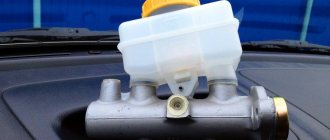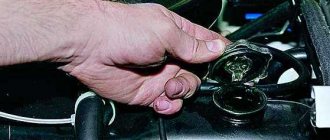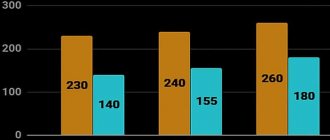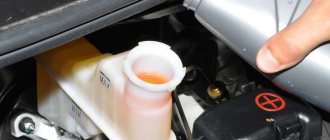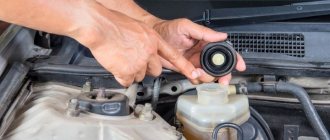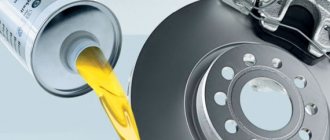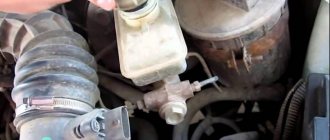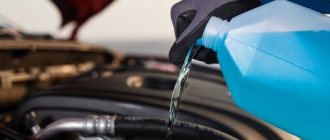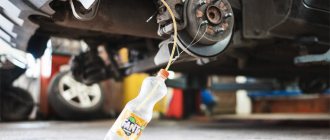Maintaining required brake fluid level necessary for proper operation of the vehicle's braking system. How much is needed can always be found in the service book, but often car owners are not used to looking into it, but act empirically or look for the answer on the Internet. It is these users that we will try to help resolve the issue. how much brake fluid do you need for replacement and which one should be poured.
Brake fluid is the working fluid of the brake system, with its help the force created in the master cylinder is transmitted to the wheel pairs.
If the brake fluid level is below the minimum mark (by the way, this will be indicated by the corresponding icon on the instrument panel - a red circle with waves inside), then you need to top it up. It also doesn’t hurt to check the master brake cylinder and the brake system as a whole, since a decrease in the fluid level may indicate a malfunction or wear of the master cylinder gaskets. As a rule, the brake system of a passenger car contains from 0.55 to 1.0 liters of brake fluid. And its specification can very often be indicated on the body of the expansion tank or its cap.
When checking, do not forget to pay attention to the color of the liquid . The new TJ is transparent with a yellowish tint. During operation, it changes its color and becomes dark, this is mainly due to the accumulation of various impurities. If the fluid has darkened, this may mean that a complete replacement is necessary and simple topping up is not enough.
Experts recommend replacing brake fluid approximately every 2-3 years ; this interval is optimal, because the shelf life of the fluid can vary depending on hygroscopicity and susceptibility to temperature loads. For the brake mechanisms to function properly, the fluid must have a number of properties and also meet a certain standard.
What is brake fluid and what are its functions?
The brake fluid in a car transmits the pressure force from the main cylinder (brake master cylinder) to the brake mechanisms of each wheel. The physical properties of liquids allow them to be used in closed circuits to instantly transfer force from one end of the line to the other.
The car's braking system consists of:
- brake mechanism;
- brake drive (hydraulic, mechanical, electric, pneumatic and combined);
- pipeline.
Most often, budget and middle-class cars are equipped with a hydraulic brake system, the line of which is filled with TZ. Previously, butyl alcohol and castor oil were used for this. They were mixed in equal proportions.
Modern liquids consist of 93-98 percent ether polyglycols. To increase the efficiency and reliability of their products, manufacturers use various additives. Their number does not exceed 7%. Sometimes silicones are used as the basis for such substances.
Types of brake fluid
Modern brake systems use different types of fluid. The first formulations were a mixture of butyl alcohol and castor oil. At low temperatures (below 0 °C), such a liquid became thick and partially lost its properties. Its complete replacement was required annually.
As the automotive industry developed, more advanced brake fluids were developed. All of them are united within the framework of standards (the so-called DOT), indicating the boiling point and degree of viscosity depending on the environment. The most common TJs:
DOT 3 is a glycol version of the liquid, which is based on two substances: polyethylene glycol and polyester. This type of brake fluid is suitable for vehicles with modest dynamic characteristics. The operating temperature in the brake system of such vehicles should not exceed 150 °C. It is permissible to mix DOT 3 liquid with a similar composition of DOT4 standard fluid.
DOT 4 is a composition based on polyethylene glycol and polyester, supplemented with special additives that prevent boiling. The most popular version of brake fluid is effective when heating the system up to 200-230 °C, which is optimal for most modern cars. Compatible with DOT 3 fluid.
DOT 5 is a brake fluid whose formula includes silicone. Created specifically for high-speed sports cars, DOT 5 fluid ensures trouble-free operation of the braking system at boiling temperatures up to 260 °C. Due to its special composition, mixing DOT 5 with glycol-based liquids is unacceptable. At the same time, the service life of silicone-based liquid is only 1 year.
DOT 5.1/ABS is a glycol compound used exclusively in brake systems equipped with an ABS mechanism. Mixing specialized brake fluid with others is undesirable.
Classification of brake fluid by type
- Mineral TJ. Based on LHM mineral oil, alcohol and castor oil.
- Glycolic TJs. Based on essential and polyglycol oils.
- Silicone TJ. This type is based on silicon-organic polymer products.
Classification according to physical and chemical parameters
- By viscosity.
- By boiling point.
Exceeding the viscosity and boiling point ranges significantly degrades the properties of the brake fluid. So, for example, if you heat the brake fluid to a temperature exceeding the maximum permissible, then some substances from the composition will begin to evaporate and a vapor lock will form. After this, it happens that the brake pedal simply falls down without effort.
When should you change?
The service life of the brake compound depends on several factors - the type of consumables, driving style, serviceability and class of the vehicle. For different conditions, the frequency of changing brake fluid is selected differently:
- On vehicles filled with DOT 3 and DOT 4 compounds, the current update is carried out once every 3 years, at least.
- Silicone-based liquids can work normally for up to 5 years, unless any emergency occurs. Accordingly, DOT 5, DOT 5.1/ABS materials need to be replaced after 4–5 years.
- Extraordinary replacement is made in case of color change. Example: during the process of repairing and bleeding the working cylinders, you noticed cloudiness of the fluid or saw floating black particles - the remains of worn rubber cuffs. The latter often clog the calibrated holes in the main and auxiliary cylinders.
- A complete update of the working environment is required after mixing materials of incompatible grades, for example, DOT 4 and DOT 5. In such cases, the system is emptied and a new fuel fluid is filled in; then it should be changed after 3 or 5 years, as mentioned above.
- After purchasing a used car, it is customary to fill in new technological fluids, including the contents of the brake system. It is unknown what the previous owner put in there and how long he drove without replacing consumables.
- Carefully read the operating instructions - manufacturers often indicate the frequency of updating the filling tanks in the car.
Note. Glycol TJ (DOT 3, DOT 4 and DOT 5.1), which is in normal technical condition, is colored yellowish or light brown, visually the material appears transparent. The silicone-based composition has a reddish tint.
If the vehicle is used for commercial purposes and travels more than 50 thousand km within 1 year, then it is recommended to replace it annually or at intervals of 40 thousand km. At the same time, the system is inspected for loose seals and leaks. Due to the harsh working conditions, the fuel fluid often has to be changed on sports cars (such as Ferrari or Lotus); manufacturers require that the fluid be updated every 15–20 thousand kilometers.
Brake fluid requirements
For road safety, every car must be equipped with a reliable braking system. To fill it, you must use a liquid with a special composition. It must meet the requirements for:
- boiling point;
- viscosity;
- influence on rubber parts;
- influence on metals;
- lubricating properties;
- hygroscopicity.
Boiling temperature
When the brakes operate, the fluid filling the system becomes very hot. This occurs due to heat transfer from the brake discs and pads. Here are the average calculations of the temperature regime of the vehicle depending on driving conditions:
| Riding mode: | Heating the liquid to C |
| Route | 60-70 |
| City | 80-100 |
| Mountain road | 100-120 |
| Emergency braking (several presses in a row) | Up to 150 |
If the circuit is filled with ordinary water, then at this temperature it will quickly boil. The presence of air in the system is critical for proper operation of the brakes (the pedal will fail), therefore the composition of the fuel fluid must include substances that increase the boiling threshold.
The liquid itself is not liquefiable, due to which pressure from the pedal is accurately transferred to the brake mechanisms, but when it boils, small bubbles form in the circuit. They displace a certain amount of liquid back into the tank. When the driver presses the brake, the pressure in the circuit increases, the air in it is compressed, causing the brake mechanisms to not press the pads so tightly against the drum or disc.
Viscosity
Since the stability of the braking system depends on the fluidity of the substance, it must retain its properties not only when heated, but also at low temperatures. In winter, the braking system must operate with the same stability as in summer.
Thick fuel fluid is pumped through the system more slowly, which significantly increases the response time of the brake mechanisms. At the same time, it should not be allowed to be highly fluid, otherwise it threatens leaks at the junctions of the circuit elements.
Table of viscosity indicators of substances at a temperature of +40 toC:
| Standard: | Viscosity, mm2/s |
| SAE J 1703 | 1800 |
| ISO 4925 | 1500 |
| DOT3 | 1500 |
| DOT4 | 1800 |
| DOT4+ | 1200-1500 |
| DOT5.1 | 900 |
| DOT5 | 900 |
At sub-zero temperatures, this indicator should not exceed 1800 mm2/s.
Effect on rubber parts
During operation of the brake system, elastic seals must not lose their properties. Otherwise, rough cuffs will prevent the free movement of the pistons or leak the fuel fluid. In any case, the pressure in the circuit will not correspond to the required value, resulting in ineffective braking.
Effect on metals
Brake fluid must protect metal parts from oxidation. This can lead to damage to the mirror of the internal part of the brake cylinder, which will cause leakage of fluid from the working cavity between the piston collar and the wall of the brake center.
The resulting irregularities can lead to premature wear of the rubber elements. This problem contributes to the appearance of foreign particles in the line (pieces of rubber or broken rust), which will affect the efficiency of the hydraulic drive.
Lubricating properties
Since the effectiveness of a car's brakes depends on the quality of the moving parts that make up their structure, they need constant lubrication for smooth operation. In this regard, in addition to the properties listed above, TJ should prevent the appearance of scratches on the mirror of working surfaces.
Hygroscopicity
One of the disadvantages of technical fluid in this category is its ability to absorb moisture from the environment. The boiling point (“wet” or “dry” TJ) directly depends on the amount of water in the liquid.
Here is a comparison table of the boiling points of both liquid options:
| Standard TZh | “dry” boils at toC | “wet” (amount of water 2%), boils at toC |
| SAE J 1703 | 205 | 140 |
| ISO 4925 | 205 | 140 |
| DOT3 | 205 | 140 |
| DOT4 | 230 | 155 |
| DOT4+ | 260 | 180 |
| DOT5.1 | 260 | 180 |
| DOT5 | 260 | 180 |
As you can see, even with a slight increase in moisture level (within two to three percent), the boiling point moves 65-80 degrees lower.
In addition to this factor, moisture in the fluid accelerates the wear of rubber parts, leads to corrosion of metal elements, and thickens more strongly at low temperatures.
As you can see, the brake fluid of motor vehicles must meet high requirements. That’s why every motorist should be attentive to manufacturers’ recommendations when choosing a replacement vehicle.
US standard
The American Department of Transportation has created a quality standard FMVSS No. 116 (Federal Motor Vehicle Safety Standard), which it is advisable to use.
If anyone doesn’t know what DOT is in the designation of brake fluid, then it is nothing more than an abbreviation of the name in English of the US Department of Transportation, that is, Department of Transporation or DOT.
Therefore, owners of new modern cars must adhere to the accepted quality standard, that is, use glycol TJ DOT 4 or glycol-silicone DOT 5.1.
And for old cars, roughly speaking, before the year 2000, you can safely use DOT 3 or BSK.
BSK brake fluid is an old brand of TZh, which is created by combining castor oil and butyl alcohol in a 1:1 ratio. Analogs of BSK liquid: Neva, RosDot, Tom, Rosa.
Characteristics of TJ DOT
- Viscosity degree.
- Maximum temperature (boiling).
- Neutral to rubber and plastic products.
- Corrosion resistance.
- The ability to maintain its properties and qualities during long-term operation.
- Ability to act as a lubricant.
- The ability to absorb or not absorb moisture from the air.
According to the American quality standard FMVSS No. 116, brake fluids are divided into 5 classes.
Some are only suitable for disc brakes, others for drum brakes.
Why does brake fluid deteriorate?
It doesn’t matter at all what brand of solution is poured into the vehicle, it immediately and quite actively begins to “absorb” moisture from the environment. There are several reasons for this:
- worn brake system seals;
- sealing flaps;
- long period of vehicle downtime;
- improper mixing of liquids being poured (including forced mixing);
- the “ventilation” system of the tank itself.
It is worth knowing that if the brake fluid absorbs only an extra 3.5% of moisture, it is able to boil much faster, which seriously increases the risk of complete brake failure or cylinder blocking. Especially when performing sudden or emergency braking. Therefore, the frequency of replacing brake fluid is at least 2-4 times a year, and if the car is old enough, it can even be increased, remembering that safety is something you cannot skimp on.
Often the need to change brake fluid is caused by using old or incorrectly mixed fluid, for example, mineral or glycol. In addition, a number of manufacturers produce unique formulations that in no case can work “paired” with other liquids.
Despite the fact that you can do all the work yourself, many, especially inexperienced car enthusiasts, are simply not aware of how to change the brake fluid in a car with their own hands. If there is no more experienced and knowledgeable car enthusiast nearby, the way out of the situation may be a visit to a service center, where the brake fluid will be replaced quickly and professionally, and the cost of the work will be quite acceptable.
What to choose?
When developing a hydraulic brake drive system, designers determine in advance what standard of composition will be used. Therefore, the question of which brake fluid is better does not make sense.
Accurate information, indicating the standard, is necessarily contained in the technical specification of the car.
Pour what is recommended by the manufacturer. Experimentation can be very expensive. As for a specific brand, it is better to trust not a beautiful label, but certificates of conformity, which a bona fide supplier must accompany products sold through the retail chain.
This is the only way you can be sure of the quality of the products you use and avoid counterfeits.
Girl replacing brake fluid. Video:
Percentage of moisture in brake fluid
An important feature of the most important liquid in a car is its hygroscopicity. This ability to absorb water vapor cannot be considered an advantage. It is this feature that leads to a change in composition for the worse, which affects its performance characteristics.
This property is especially dangerous at low temperatures. In severe frosts, braking becomes more difficult. This happens because the liquid has taken on water. The system needs to be flushed and updated.
In hot weather, on the contrary, boiling may occur due to the large amount of water in the liquid. This can lead to poor braking on steep descents when you have to constantly press the brake pedal. Or in the city, where you need to press the brake often. To avoid an accident, you need to urgently change the brake fluid.
There is a parameter by which you can determine that it needs to be replaced. The percentage of moisture in it should be no more than 3.5%. To find out how much moisture has accumulated, you can use a special device. It can be purchased at any specialty store. The cost of the device is low, it is easy to use and every car enthusiast will need it.
Existing types of ABS systems
The sequence of changing ABS brake fluid is essentially a simple and trivial procedure. Despite this, the modern auto industry takes into account safety trends: almost all car models are produced with ASC and EBD systems installed. These components are controlled by the exchange rate stability system - ESP.
In this regard, replacement of TZ is carried out only in authorized service centers. The reason for this lies in the need to connect the ECU to a diagnostic scanner. On those cars in which the valve system and pump with hydraulic accumulator are represented as separate units, it is impossible to change the brake fluid yourself for the same reason.
Brake fluid change intervals
Replacement can be planned or unscheduled. The planned one is usually carried out after a certain mileage. Unscheduled replacement is carried out:
- if the brake system has depressurized;
- after a long period of inactivity;
- after intensive use;
- after the purchase.
It is important to monitor the frequency of brake fluid changes. Experts recommend replacing after 30,000 - 60,000 km or after every two years of operation. It is advisable to change the TZ in sports cars after 15,000 km. Such cars have high speed limits. These recommendations are conditional. Replacement dates in rare cases, for example, if DOT 5 with a silicone component is used, are shifted once every five years. If a glycol-based fluid is used, then it needs to be changed after 40,000 km.
A low level does not create the required pressure during braking. In such a situation, the brake pedal fails. A red circle on the panel warns of a drop in level.
The liquid just doesn't disappear for no reason. She works in a confined space. A decrease in level may occur due to a leak or malfunction of the brake system mechanisms. A signal for replacement can be visual inspection, that is, if sediment, a change in color or cloudiness is noticed during inspection.
TJ is hygroscopic. When you press the brake pedal, air enters the compensation holes. The fluid in the system absorbs moisture from the air. As a result, the more moisture accumulates, the lower the boiling point and the viscosity at low temperatures increases. The boiling point of fresh liquid is within 230C, but with a moisture content of only 3%, boiling occurs at 165C. A decrease in temperature contributes to the appearance of steam blocking of the brakes.
Additional Information! Service stations have instruments that diagnose moisture content.
Those who believe that it is enough to simply add fuel fluid when necessary are mistaken. But it is necessary to completely replace the brake fluid. Due to its hygroscopicity. Fresh fluid, when mixed with already used fluid, does not meet safety standards. The newly obtained mixture does not acquire its original qualities. The operation of the entire system will be slowed down, and corrosion may occur.
Reminder! The brake system cannot function without a brake system. Reuse of TJ is unacceptable.
How to check the brake fluid in a car?
The services use a brake fluid tester; it can be purchased at an auto store. It is necessary to make a small sampling of material, or lower the device into the expansion tank on the master brake cylinder. It determines the main quality indicator - boiling point. Externally, it is difficult to estimate how much moisture is in the brake fluid. The color practically does not change, clouding does not occur.
The normal value is 175 °C and above. If the liquid boils at a lower temperature, it is dangerous to continue operating the car.
Another way is to visually check the brake fluid. Even if the color remains the same, the worn-out liquid becomes cloudy and a suspension appears in it. These could be wear products from the system or flakes from additives that have lost their effectiveness. It's good to have a small amount of fresh brake fluid of the same brand for comparison.
Self-expanding mechanism
Therefore, the cylinders are equipped with a self-propelling mechanism. This mechanism prevents the pistons from returning to their original position. It is arranged as follows. There is a slot on the piston. In which a split ring is inserted. This ring, when installed in the cylinder, compresses and holds the piston in a certain position.
The slot allows the piston to move relative to the expansion ring. Exactly as much as necessary to release the brake pads. However, this working move will not be enough. When you press the pedal, the expansion ring moves with the piston and locks into place. In this case, the piston will not be able to return to its original position. And it will move as far as the size of the expansion ring groove allows it. Typically 2-3 mm. The pistons will diverge, and the volume of liquid in the working cylinders will increase.
Therefore, it is necessary to periodically add fluid to the expansion tank if the brake system is working properly. The system is completely sealed, there is no air in it. When pouring liquid into the expansion tank, air bubbles form, but they quickly come out of it. And they do not pose any danger.
How much brake fluid is needed for a complete change?
The quantity depends on the size of the car and the presence of an ABS system. From 0.55 to 1.0 liters of liquid is poured into a conventional machine. Only for some car models the volume may be larger. For example, Toyota Prado 150 and Hyundai Accent will require 1.5 liters or slightly more DOT 5.1.
The specific interval is determined by the fluid standard and driving characteristics. Experts recommend replacing it after 40-60 thousand kilometers. For example, with intensive use, replacement is needed every 5,000 - 10,000 km.
Under what circumstances is it necessary to replace the brake fluid?
To understand how much brake fluid may be required to replace consumables in the system, you need to answer one simple question - when does the need for such a procedure arise.
The fact is that many motorists do not read the recommendations in the car service book, although this is necessary. As a result, the driver does not pay attention to obvious signs of deterioration in the condition of the braking system.
The vast majority of motorists follow the old and, in their opinion, proven scheme - they simply top up the brake fluid as needed.
In fact, you can't do that. I advise experienced mechanics in this matter to focus on the indicators on the dashboard, where there is a corresponding symbol. If the level has dropped to a minimum level, then it is time to take serious measures.
Of course, you can simply add fluid, but after this procedure you will need to perform a full check of the serviceability of the brake system.
Brake fluid cannot simply decrease. If the level has decreased, it means that a leak has formed somewhere or a problem has arisen in the operation of the main brake cylinder. It happens that the substance is supplied unevenly to the wheels.
Average volume of brake fluid in a car
Replacing fluid in the brake system can be planned, or it can be an emergency. Usually, if repairs to this important part of the car begin, the substance is completely drained. It is highly not recommended to re-fill the TJ into the system, since it has already lost all its working qualities. The optimal solution would be to purchase a new composition.
Many novice drivers are interested in how much brake fluid can be in a regular passenger vehicle. A lot depends on additional equipment (for example, ABS), but usually no more than 550 - 1000 ml. In other words, you don’t need a large container to drain the waste substance.
What does the car need - topping up or completely replacing the brake fluid?
Before proceeding to active actions, the driver should clearly understand what he will do - just longer TJ or he will need to completely change the substance.
The first procedure is simpler, since it is enough to add liquid, and then make sure that there is enough of it for the entire system to fully operate. The second option is more inconvenient, since you will have to completely drain the brake fluid, flush the system and fill in a new compound.
There are several criteria to accurately answer this question, namely:
- the car has already covered 50-60 thousand km on liquid alone;
- The car was used for two to three years.
Actually, these two factors are enough to make a decision to replace the substance. The fact is that over the past time, the TJ has already absorbed a lot of water and has completely or partially lost its technical properties.
An exception may be a situation where the car has been idle for a long time, or has been used too intensively (up to 80-100 thousand km per year). Here only refilling of the substance is possible.
What factors influence the need to replace the diesel fuel?
There are a number of other points that may influence the decision to replace. For example, if a driver drives a vehicle too aggressively and prefers a sporty style, then replacing the brake fluid will be required much more often.
The issue is similar with the specification and type of TJ. The better the quality of the product, the longer it will retain its technical parameters. For example, the popular brake fluid DOT 4 is designed for 50-60 thousand km.
Mechanics advise updating such a substance with the specified regularity, or after repairs have been carried out. Much depends on the operating conditions of the car. The more complex the geography, terrain and climate, the shorter the period of use of transport will be. The brake system will also wear out more intensively.
Is it possible to mix brake fluids?
DOT 3 class is perfect for passenger cars with drum brakes or with disc brakes on the front axle and drums on the rear axle. It contains glycol, making the price of a liquid of this class affordable. But the downside of this composition is the high absorption of moisture. A liquid of this class quickly accumulates moisture to a critical ratio.
DOT 4 class is one of the most popular among motorists. This fluid is suitable for all cars, in particular, with disc brakes on all axles. Its chemical composition includes ester compounds in combination with boric acid. Thanks to this composition, moisture in a liquid of this class is almost completely neutralized. This brake fluid will serve the car enthusiast for a long time.
The DOT 5.1 class is well suited for a sports car whose braking system is subject to heavy loads. Liquid class DOT 5.1 has the same composition as DOT 4, but due to the improved formula it can withstand a higher boiling point and provides more effective moisture absorption.
DOT 5 brake fluid is not often used on regular cars. It contains silicone, which makes it hygroscopic. But there is still one fundamental disadvantage to this. This brake fluid allows water to accumulate in the brake hoses of the system. This can lead to oxidation of system elements or freezing of water at temperatures below 0 C.
Liquids of the same class, but from different manufacturers, can be mixed with each other. It is not advisable to mix liquids of different classes. But if necessary, you can combine DOT 3 and DOT 4, DOT 4 and DOT 5.1. In this case, you must remember the rule that only liquids of the same or higher class can be added to liquids of a lower class. But under no circumstances should you add fluids of other classes to DOT 5 fluid, as this can lead to serious problems in the braking system.
Important! Is it possible to mix brake fluids? Due to the fact that DOT 5 uses different chemicals that are found in DOT 4 and DOT 3. Therefore, you cannot mix DOT 5 with DOT 4 or with DOT 3. Also, if the operating instructions for a particular car say that you cannot If you use brake fluid other than DOT 5, then DOT 3 and 4 cannot be poured into the brake system of such a car.
Which TCs can be mixed
If we talk about whether it is possible to mix brake fluid from different manufacturers, then remembering compatible brake fluids is very simple. Today there are several brake standards, which are designated by DOT markings:
- DOT 3 is a glycol fluid that is made from polyethylene glycol and polyester. Used for low-speed cars, in the brake system of which the operating temperature does not exceed 150 degrees. This formulation can be mixed with a similar DOT4 glycol fluid.
- DOT 4 is a glycol composition that contains additional additives. Boils at higher temperatures (200-230 degrees). Used for high-speed vehicles. This composition can be mixed with the previous one.
- DOT 5 is a silicone based liquid. Used for sports cars. The boiling point reaches 260 degrees. Mixing such TJ with any glycol composition is strictly prohibited.
- DOT 5.1/ABS is a glycol fluid that is used exclusively for cars with an ABS system. Such compositions also cannot be mixed with other pillboxes.
As you can see, “mixes” can only be made from DOT 3 and DOT 4. The manufacturer is not so important, since these compositions have similar characteristics and bases.
How many TJs are contained in VAZ models?
Most often, quite practical and inexpensive Dot 4 liquid is poured into the cars of the Volzhsky Automobile Plant. The systems of classic models (from VAZ-2101 to VAZ-2107) do not contain so much of it - 0.55 liters, but more modern Ladas (VAZ-2114, “Kalina”, “tenth” family) already require a whole liter of brake fluid. However, if you plan to flush the system, it is better to purchase a little more liquid than required. One and a half liters will be enough, but since packaging is done only in liter containers, it is better to take two such packages.
It is also useful to know that most of the liquids used (in particular Dot 3 and Dot 4) cannot be stored open for too long: a maximum of two years!
Which brake fluid is better to choose?
In order for vehicle mechanisms to operate without failure, the brake fluid must meet the standard. The standards developed by the US Department of Transportation - DOT are adopted as the basis. There are also European standards SAE 1703/1704; ISO(DIN)4925.
Quality requirements:
- Viscosity.
- Temperature. That is, the ability to work at -30 to +150C to ensure the functioning of the hydraulic drive.
- Inertia. The composition should not contain aggressive components, both metal and rubber.
- The properties of the brake fluid must be stable within the operating temperature.
- Lubricating properties for internal surfaces.
Any fuel fluid contains from 2 to 7% additives. These components create quality characteristics.
Brake fluids are divided into types:
- Mineral. Ingredients: alcohol and castor oil.
- Glycolic. The base is polyglycols and their esters.
- Silicone. The basis is silicon-organic polymer products.
There are differences:
- By viscosity.
- By boiling point.
According to FMVSS No. 116, there are five different classes for use in vehicles operating in certain conditions. Or they were created for different mechanisms - disk, drum.
- DOT 3 – designed for use in low-speed vehicles with both drum and disc front brakes. Boiling point 220° C.
- DOT 4 – designed for high-speed vehicles with disc brakes on both axles. Boiling occurs at temperatures of 240° and 160° C.
- DOT 4+, DOT 4 SUPER - both products are modifications of DOT 4. Boiling point 260°C and 180°C.
- DOT 5 is a silicone product. Recommended for cars with ABS system. It does not absorb moisture; it collects in a designated place. Boiling point 260°C and 180°C for “dry” and “wet” liquids. Used in racing cars.
- DOT 5.1 - for high-speed cars whose brakes are overloaded. The liquid is high-tech, has good flow properties, and absorbs moisture. Recommended for use with ABS and ESP systems. Operating temperature 270°C and 180°C.
Attention! You cannot mix products of different classes. Each product contains individual additives.
How to change brake fluid yourself?
In some modern cars with complex “sophisticated” ABS, ESP and SBC systems, it is easier to replace the brake fluid at a specialized car service center. This will take a little time (about 30 minutes), the system will not be air-filled, and the price is within 1000 rubles. not so scary.
For those who like to save money, and also in the absence of trust in the service station employees, you will have to change the brake fluid yourself. To work you will need several tools, devices and materials:
- a soft transparent tube, the inner diameter of which corresponds to the outer diameter of the bleeder fitting on the wheel cylinder;
- an open-end or socket wrench for unscrewing the “bleeder”;
- container for collecting used brake fluid;
- new fluid;
- reliable assistant.
It is better to carry out the work in a viewing hole or on an overpass. If you can get to the bleeder fittings from below with a wrench and a tube, then it is not necessary to remove the wheels. Otherwise, you will need a jack and a wheel wrench, and you will also have to spend extra time dismantling and installing the wheels.
This procedure is not at all complicated and does not require special equipment. You need a 4-5 mm transparent tube, a 1-2 liter glass container, a large-volume medical syringe and a wrench (the size is different for each car).
- Use a syringe to pump out as much liquid as possible from the tank;
- Add fresh water to the level;
- We ask the assistant to press the brake pedal several times and keep it pressed;
- We put a transparent tube on the bleeder fitting (located on the calipers), lower it into the container, and open the fitting with a key. After reducing the pressure, tighten the fitting and add liquid to the tank;
- We repeat the procedure. Having seen that fresh liquid is flowing from the tube, we move on to the next wheel.
The replacement (bleeding) sequence is as follows:
- right rear;
- left rear;
- right front;
- left front wheel.
Then add liquid to the level between the marks.
Replacement starts with the longest and ends with the shortest line. In systems with ABS, after replacement, it is recommended to perform several vigorous braking on a slippery surface to open the valves. Then replace the fluid in the tank (without pumping).
Our brand
General recommendations in all cases of work when changing the fluid on a car with your own hands:
- Do not allow the chemical to come into contact with your hands, inside the body, or on wires or paintwork;
- it is necessary to use exactly the chemical specified by the manufacturer of the car brand;
- Store leftovers in containers tightly closed.
So, let’s take an example of the operation of replacing the brake fluid on a VAZ 2110 car. We will describe what you need to have on hand below:
How much fluid we need is indicated by the car’s passport. For VAZ 2110 this is 0.55 liters. Let's get started.
- Open the system reservoir.
- We lift the rear of the car, unlock the rear brake pressure regulator - insert a screwdriver between the piston and the plate.
- We release the air release valve of the right rear brake from the rubber cap, insert a hose, the end of which is connected to a container.
- The partner must sharply press the pedal 5 times, and leave it pressed the last time.
- At the same time, we unscrew the valve with a wrench - just make three quarters of a turn, the spent medium should begin to flow out. After the leak stops, tighten the valve, and your partner should not release the pedal until the fitting is tightened.
- It is necessary to add new medium as soon as the tank is empty to the bottom mark. When clear liquid flows out, the operation stops.
- We repeat everything completely on the left front brake mechanism.
- Then we repeat the manipulations again for the second circuit - first we move to the left rear mechanism, and at the end - to the right front.
- We install the caps back, remove the screwdriver from the pressure regulator, and check the efficiency of the system.
Safety rules when performing work
When performing work, you should follow simple safety rules, which will protect you from all kinds of misunderstandings.
- Use only fuel oil recommended by the car manufacturer.
- When partially replacing the fluid, it is necessary to use the one that is already poured into the system. Do not use a fluid that has already worked before (even if it is “clean”).
- TJ is highly toxic. Special care and caution is required in performing all actions. Do not allow liquid to get into the mouth or skin! Avoid inhaling brake fluid vapors.
- TJ should be stored in a high-quality container without access to air.
- While working, you should always have rags and water “at hand” to eliminate possible liquid getting on the car body.
- Avoid contact of mineral oils with fuel fluid, as this can lead to very serious consequences, including breakdown of the entire system.
- Do not allow liquid fluid to come into contact with electrical wiring - this will destroy the insulation.
- Do not change the permissible volume of brake fluid when replacing - if you need to fill 1.5 liters, that’s how much it should be.
- If you only need to add a small amount of new solution to the system, you can only use the brand that is already poured into the system.
- Do not use rags soaked in oil.
We fill the fuel with a running engine and a reliable braking system is a guarantee of safety on the road. To prevent the brakes from failing in an emergency, you need to regularly perform partial or complete replacement of the brake fluid. The most important condition for this is the optimal interval for performing the procedure - it must be strictly adhered to!
Remember - even the slightest change in the color of the fuel fluid indicates a change in its characteristics.
Stages of work
Professionals use a special installation to replace the TJ, but at home you can do without it. The essence of the process is to drain the old substance from each brake caliper through a special fitting, making sure that there is no air in the reservoir. Process steps:
- We look for the cylinder where the brake fluid reservoir is located and remove the cap from it.
- Using a syringe, pump out the old liquid into a plastic bottle.
- Before we fill in a new TZ.
- Jack up the car and remove the wheel.
- Remove the protective cap from the rear fitting valve.
- We put a transparent hose on the fitting, place its other end in a bottle into which the old liquid was drained.
- Loosen the fitting nut with a wrench and quickly return it to the reverse position. When the nut is soured and cannot be touched, it is necessary to knock it down and continue replacing.
- The next step requires an assistant to sit behind the wheel and apply and release the brake several times. 4-5 times will be enough, and the last time you should press all the way and not let go. At this time, at a signal, you need to loosen the nut and after a couple of seconds return it to its original position. Only then can you release the brake pedal.
- It is necessary to perform these manipulations on each wheel 6–7 times, if you have patience, then more is better.
- Check the presence of fluid; when the level is below about 0, add more. At the end, press the pedal again and if it does not sag, then the replacement was successful.
Replacement and pumping
Adviсe:
- Please note that during operations the car must be turned off; to be sure, remove the key from the ignition;
- the bleeding process should begin with the rear left wheel , then move to the right rear wheel, then the left front and front right;
- pump the first fitting until all the old fluid comes out. You can easily distinguish it from a new one by its color. We bleed the other fittings as usual;
- Make sure that the tank is not empty, otherwise you will take in air. When bubbles are noticed when draining the used substance, pump until they disappear altogether.
In what situations do experts recommend bleeding the entire brake system of a car:
- for a large amount of time there is a violation of control (the car suddenly drives in different directions);
- the substance was replaced not at the service center, but independently, by an inexperienced driver;
- pressing the brake pedal, you feel that it is too soft;
- The vehicle's brake system has recently been repaired.
Timely replacement of brake fluid is a very important procedure. Many people don't understand this. Because if you don’t do this, you can simply be left without brakes or without a clutch.
As mentioned, over time, synthetic brake fluid can absorb water. Water can cause corrosion within these systems. Water can freeze in severe frost. Water destroys working and master cylinders, which are not cheap even for a domestic car.
From this we can conclude that it is necessary to change the brake fluid on time and it is better not to skimp on it.
Basic mistakes
- Mix different TJs.
- Do not allow the level to drop below the minimum. That is, to prevent air from entering the system.
- Do not raise the pressure in the tank more than 0.8 atmospheres, otherwise it may explode.
To replace used material with your own hands, you will need to spend a couple of hours of free time on a weekend. The preparation process takes longer. Preliminary preparation will help beginners to be clear and correct in their actions. The main thing is to prevent air from entering the system.
The working cylinders in the vehicle's brake system communicate with the main cylinder through brake fluid. Thanks to their coordinated work, the movement of the master cylinder piston is transmitted to the brake cylinders, and then to the pads. Brake fluid is subject to constant heating, but due to its special composition it does not boil, even if the temperature in the system is above 100 degrees for a long time.
The disadvantage of the composition is its hygroscopicity. Brake fluid is capable of absorbing moisture from the external environment. If it contains more than 3% water, the liquid will lose its effectiveness. If depressurization occurs, air containing vapor that is dangerous to the brake fluid may enter the system. In other words, when air and water enter the system, the boiling point of the brake fluid will drop sharply and at a certain point it will begin to boil.
When boiling, the working volume of the liquid becomes larger and when you press the brake pedal, the “excess” liquid is poured into the reserve tank. After cooling, compression occurs and the previously displaced volume may not be enough to create the required pressure in the system. In such cases, the driver feels like the brake pedal falls without resistance, which is very dangerous when driving at high speed. This is why you need to monitor your brake fluid levels and know exactly when to change your brake fluid.
When the safety of car operation is at stake, it is better to turn to professionals. The periodicity of updating the working solution depends both on the manufacturer’s recommendations and on other factors. An experienced auto mechanic will accurately assess the condition of the brake fluid.
Self-replacement without assistants
Usually they buy TJ with a capacity of 1 liter. When replacing for passenger cars, 0.55 liters is usually used, regardless of the size of the car, cross-country ability, or the presence of ABS.
The most commonly used grade is DOT-4. This is the most popular product. They change it as a result of its high hygroscopicity. DOT-4 actively absorbs moisture from the air, and therefore loses its characteristics.
Reminder!
TJ should not be stored in an open container for a long time; it retains its quality for only two years!
Before replacing, first install the car on an inspection hole or overpass. There must be free access to the place to drain the waste material and then fill the tank. You need easy access to the brake cylinders of four wheels.
Adaptations
- Key for 8 or 10.
- Bulb or syringe.
- A piece of hose – 4 pcs.
- Collection container – 4 pcs. Plastic bottles will do.
- Rags.
Step-by-step instruction
The process is:
- Find the brake master cylinder and brake fluid reservoir in the car.
- Then you need to unscrew the tank cap.
- Pump out the remaining liquid from the tank using a bulb or syringe.
- Unscrew the fittings from all brake devices on the wheels.
- Place the end of a transparent hose onto the valve fitting, and lower the other end into a plastic bottle. The hoses must fit tightly.
- Make sure that any remaining liquid flows through the hoses into all bottles.
- It is necessary to monitor the drainage and gradually add fresh liquid to the tank. Filling should prevent the tank from drying out.
- If the bottle on the front left wheel is filled to approximately 200 ml, you should tighten the fitting on this cylinder. The procedure is repeated on all wheels. On the rear, filling can reach 250 ml.
- You need to screw in the fittings after you are sure that the fresh mixture has begun to flow into the bottle.
- Check the tightness of the tightened fittings. Put on the caps. Check the filling level.
- After an independent change, pumping is required.
Basic mistakes
- Mix different TJs.
- Do not allow the level to drop below the minimum. That is, to prevent air from entering the system.
- Do not raise the pressure in the tank more than 0.8 atmospheres, otherwise it may explode.
Reminder! For regular replacement, you need to use those brands of products that are recommended by the car manufacturer. The rule says you can't mix different classes! However, it is possible to mix DOT 3 with DOT4 to improve the quality. But you can’t pour DOT 3 into DOT4.
Advice from experienced car owners
We found out how often the brake fluid is changed. Below are some warnings for experienced drivers:
- replace based on the manufacturer's recommendations;
- mix TFs within the same class (it’s better to always use the same one);
- – follow the instructions;
- there should be no H2O;
- if contaminated, prompt replacement is required;
- in a car without ABS, do not allow the fuel fluid level to reach a critically low level when pumping;
- do not create excess pressure in the expansion tank;
- Wipe the tank only with a cloth (water is prohibited).
When deciding to change the solution, take into account the mileage and condition of the car’s brakes. Don't forget the car manufacturer's recommendations. The shelf life of the brake fluid is limited, and it must be renewed.
If you prefer to contact a specialized service station, use Uremont. Here you will quickly find a car service suitable for your location, read reviews from aggregator visitors and receive a response to your application in an average of ten minutes.
Most manufacturers suggest replacing it every two years. On the other hand, as far as distance is concerned, 40,000 kilometers is the milestone after which you will need a replacement. Please remember that each manufacturer has specific requirements that you should read in your user manuals.
Myths about brake fluid
There are several misconceptions about TJ, which are taken for granted by many drivers.
The first myth is the closed mode of brake fluid operation. Compensation holes present in the brake system of a car are responsible for the movement of air inside it. Along with air flows, moisture vapor gets inside and is absorbed by the fuel fluid, which leads to a loss of its properties.
The second myth is about the possibility of mixing different liquids with each other. Of course, this can be done, but not in every case and not with all compositions. Depending on the car model and its design features, certain standards are applied in the production of the vehicle. For this reason, you can add liquid of a different brand and manufacturer, but in extreme cases and in small quantities.
The third myth is that fluids that meet the DOT-4 standard can be poured into any car. This is not entirely true; A specific type of fluid corresponds to a specific make and model of a car. You should adhere to the requirements of the car manufacturer - safety and life are much more expensive than the price paid for a bottle of TJ.

